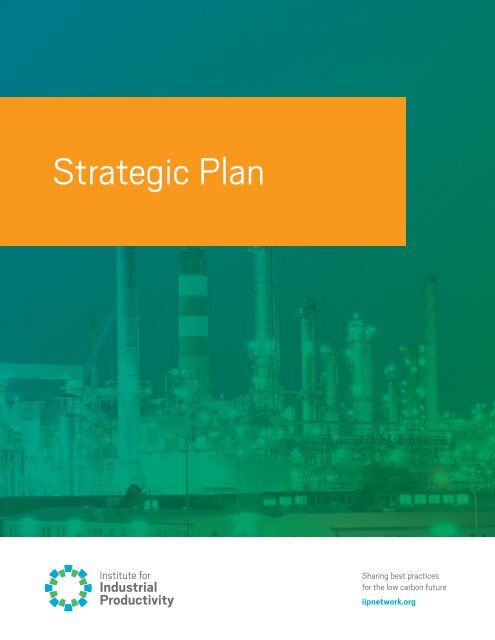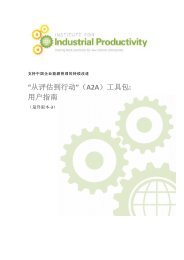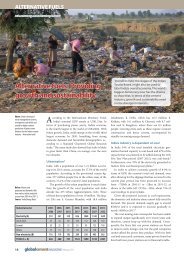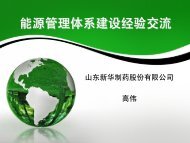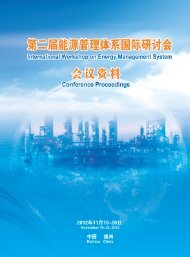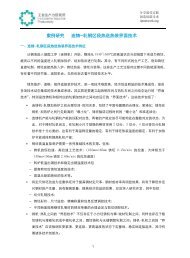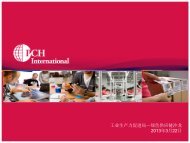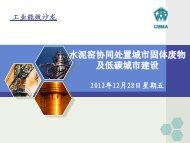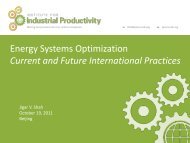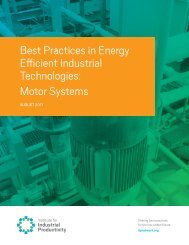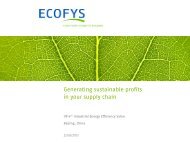Strategic Plan - Institute for Industrial Productivity
Strategic Plan - Institute for Industrial Productivity
Strategic Plan - Institute for Industrial Productivity
You also want an ePaper? Increase the reach of your titles
YUMPU automatically turns print PDFs into web optimized ePapers that Google loves.
<strong>Strategic</strong> <strong>Plan</strong><br />
Sharing best practices<br />
<strong>for</strong> the low carbon future<br />
iipnetwork.org
Role of the <strong>Institute</strong> <strong>for</strong> <strong>Industrial</strong><br />
<strong>Productivity</strong><br />
The <strong>Institute</strong> <strong>for</strong> <strong>Industrial</strong> <strong>Productivity</strong> (IIP) maintains a<br />
network of policy, technology, and finance experts to identify,<br />
analyze, and share best practices, tools, and in<strong>for</strong>mation<br />
that can boost the effectiveness of government and industry<br />
ef<strong>for</strong>ts to significantly reduce industrial energy intensity and<br />
greenhouse gas (GHG) emissions while improving productivity.<br />
Energy use and CO 2<br />
emissions will almost<br />
double by 2050 if current trends persist. This<br />
would put the world on the path towards a 6 ° C<br />
rise in average global temperature.<br />
IEA, Energy Technology Perspectives, 2012<br />
Urgent Situation<br />
<strong>Industrial</strong> activities today account <strong>for</strong> nearly a third of global energy demand and almost 40%<br />
of carbon dioxide (CO 2<br />
) emissions. Rapidly growing economies are expected to significantly<br />
increase industrial energy demand through 2030. Given the attendant risks to climate, energy<br />
security, and business, governments and industry have gained a renewed respect <strong>for</strong> the many<br />
economically attractive ways to simply decrease industrial demand <strong>for</strong> energy.<br />
Making more efficient use of the energy we have today—eliminating waste and doing more<br />
with less—offers the cheapest and most immediate route to improve energy security and<br />
avoid harmful emissions.<br />
<strong>Industrial</strong> Direct CO 2<br />
Emissions by Region<br />
Converging factors make this a critical time to<br />
refocus global ef<strong>for</strong>ts on increasing industrial<br />
energy productivity and sustainable production<br />
worldwide:<br />
• Rising demand <strong>for</strong> global resources<br />
• New capital investments<br />
• <strong>Industrial</strong>ization of emerging countries<br />
• Climate change<br />
Source: IEA, Energy Technology Transitions <strong>for</strong> Industry, 2009.<br />
* Assumes global enery-related CO 2<br />
emissions in<br />
2050 will be half of 2005 levels.<br />
To address this urgent need, IIP provides specialized expertise in the policies, programs,<br />
financing, and technologies required to accelerate reductions in the intensity of industrial<br />
energy use and carbon emissions in key regions around the globe.
IIP Vision <strong>for</strong> Industry<br />
By 2020, advanced technologies and<br />
energy management practices will be in<br />
broad use across industry—significantly<br />
reducing life-cycle process and product<br />
energy requirements; usage intensities<br />
<strong>for</strong> energy, water, and other resources;<br />
and associated carbon emissions. This<br />
industrial culture change will energize<br />
economic growth and help mitigate severe<br />
climate impacts. Supportive government<br />
policies and a public-private network <strong>for</strong><br />
sharing best practices and results will<br />
reduce carbon intensity and encourage<br />
greener manufacturing.<br />
By 2030, the industrial sector will<br />
make rigorous use of a wide range of<br />
smart manufacturing practices such<br />
as innovative materials and processes,<br />
automation and control systems, cradleto-cradle<br />
design, full cost accounting,<br />
industrial ecology principles, and carbon<br />
mitigation strategies. These practices will<br />
further boost industrial productivity and<br />
significantly lower the carbon intensities of<br />
energy and materials use while providing<br />
sustainable solutions to the global energy<br />
economy.<br />
By 2050, industrial hubs will<br />
be models of green industry,<br />
demonstrating integrated, optimized,<br />
networked, next-generation systems to<br />
minimize carbon intensity throughout<br />
the supply chain (e.g., closed-loop<br />
manufacturing systems with near-zero<br />
discharge). Significant use of renewable<br />
energy sources, highly efficient<br />
manufacturing processes, recycling,<br />
and carbon capture and re-use will<br />
enable high-quality industrial products<br />
with minimal embodied energy and lost<br />
carbon.<br />
IIP Goals<br />
IIP activities are designed to achieve two overarching goals:*<br />
••<br />
Drive a reduction in industrial energy intensity averaging 3.5% per year through 2030 in<br />
China, India, and the United States through 2030.<br />
••<br />
Contribute to a 25% reduction in annual GHG emissions by 2020 (avoiding 2.0 GtCO 2<br />
per year) and a 50% reduction by 2030 (avoiding 2.7 GtCO 2<br />
per year) in the industrial<br />
sectors of these countries.<br />
Historical and Goal-based Reductions in Energy Intensity and CO 2<br />
Emissions through 2030<br />
Note: <strong>Industrial</strong> energy intensity in 2000 U.S. dollars.<br />
Source: UNIDO <strong>Industrial</strong> Development Report 2011 (historical data), IIP Goals (projections)<br />
* Basis of goals: Reaching the aggressive yet achievable IIP goal of reducing energy intensity 3.5% per year compared to<br />
baseline projections would provide a 25% decrease in industrial final energy use and emissions in 2020, compared to<br />
baseline projections. Achieving a 50% reduction in industrial GHG emissions by 2030 will require emissions reductions<br />
beyond the 3.5% annual improvement in energy intensity relative to baseline projections. These reductions are most likely to<br />
be achieved through fuel switching (including low-carbon electrification) and limited application of industrial carbon capture,<br />
storage, and reuse.
Global <strong>Industrial</strong> Energy Use by Country, 2009<br />
<strong>Strategic</strong> Focus<br />
IIP focuses its ef<strong>for</strong>ts on countries and sectors that drive world industrial demand while<br />
offering major opportunities <strong>for</strong> improvement.<br />
Country Focus<br />
IIP concentrates ef<strong>for</strong>ts on the following three countries, which collectively use 47% of<br />
global industrial energy and produce 54% of energy-related industrial CO 2<br />
emissions:<br />
••<br />
China<br />
••<br />
India<br />
••<br />
United States<br />
Sector Focus<br />
Within these countries, IIP seeks to maximize its impacts on industrial energy use and<br />
emissions by focusing primarily on three of the most energy-intensive industries:<br />
••<br />
Cement<br />
••<br />
Chemicals<br />
••<br />
Iron and steel<br />
Global <strong>Industrial</strong> Energy Use by Sector, 2009<br />
To facilitate work with these and other energy-intensive industrial sectors, IIP maintains<br />
offices in: Beijing, New Delhi, Paris, and Washington, DC.<br />
Source: IEA Online Data Services –<br />
World Energy Balances and CO 2<br />
Emissions from<br />
Fuel Combustion (accessed 2012)<br />
Three Integrated Strategies
Strategy<br />
IIP provides critical analysis, in<strong>for</strong>mation, tools, and expert support to assist government and<br />
industry—the two most essential groups in generating large-scale improvements in industrial<br />
energy efficiency.<br />
Our three main strategies are mutually rein<strong>for</strong>cing. We assist governments in tailoring<br />
policies to more effectively foster improved industrial energy efficiency, and we team with<br />
industry to promote effective use of energy management systems and investment plans to<br />
take advantage of supportive government policies. We develop key enabling resources to<br />
assist both of these key stakeholder groups in implementing effective programs. Academia,<br />
non-profit organizations, and other groups contribute to and benefit from our work.<br />
1. Work with Governments to Improve Policy Making<br />
Create resource materials and pursue activities that help government policy makers develop,<br />
implement, and monitor improved energy and carbon per<strong>for</strong>mance in industry:<br />
••<br />
Help design, implement, monitor, and evaluate policies that encourage industry adoption<br />
of energy management systems (EnMS).<br />
Policy Areas of Interest<br />
• Voluntary programs<br />
• Standards<br />
• Tax and fiscal incentives<br />
• GHG targets<br />
• Measurement and verification<br />
• Recognition<br />
• Support <strong>for</strong> policy implementation<br />
••<br />
Advise on standards, incentive mechanisms, voluntary programs, and complementary policies.<br />
••<br />
Assist in developing policy implementation guidelines, appropriate benchmarks, industry<br />
targets, and in<strong>for</strong>mation collection mechanisms.<br />
••<br />
Organize and convene <strong>for</strong>a, workshops, and online events to bring together key policy<br />
makers and industry experts to help craft effective government policies.<br />
2. Team with Industry to Implement Energy Efficiency Best Practices<br />
Work with industry to facilitate implementation of energy efficiency best practices and<br />
EnMS to substantially reduce energy intensity and carbon emissions:<br />
••<br />
Help companies develop targets, baselines, and benchmarks and assist them in implementing<br />
plant assessments and other strategies to achieve energy and carbon savings.<br />
••<br />
Develop and disseminate energy system optimization tools and approaches.<br />
••<br />
Develop and demonstrate alternative approaches to financing energy efficiency measures<br />
and advanced technologies.<br />
••<br />
Develop approaches to implement EnMS in companies that account <strong>for</strong> a significant<br />
portion of demand and face structural challenges (e.g., numerous locations, diverse<br />
products or processes).<br />
3. Develop Critical Resources and an Integrated Network to Catalyze Major<br />
Improvements in Energy and Carbon Management<br />
Assist industry and government in overcoming technology, policy, and financing hurdles to<br />
increase industrial productivity:<br />
••<br />
Organize and convene multi-disciplinary teams to develop and tailor integrated solutions <strong>for</strong> focus<br />
areas and provide viable models and resources <strong>for</strong> expediting energy efficiency improvements.<br />
••<br />
Develop global databases on technologies, programs, policy, financing, and supply chain initiatives.<br />
••<br />
Enhance understanding of innovative measures, such as full cost accounting, cradle-tocradle<br />
design, and supply chain programs.<br />
••<br />
Develop targeted in<strong>for</strong>mation on global best practices, energy management systems,<br />
voluntary programs, per<strong>for</strong>mance standards, and certification.<br />
See IIP’s Policy Pyramid at http://iepd.iipnetwork.org<br />
Energy Management System (EnMS)<br />
An EnMS is a systematic approach to<br />
monitoring, controlling, and saving energy<br />
in an industrial facility to achieve continual<br />
improvement in energy efficiency, productivity,<br />
and cost-effective operation. This approach<br />
involves setting energy goals, policies, and<br />
targets; developing baselines of energy use<br />
and identifying energy per<strong>for</strong>mance indicators;<br />
assessing opportunities; establishing plans;<br />
and periodically reporting progress.<br />
Sector- and Country-Specific Resources<br />
A database containing technical best practices<br />
is being developed specifically <strong>for</strong> IIP’s sectors<br />
of interest, such as iron and steel and cement.<br />
Databases tailored to IIP focus countries are<br />
also under development. Please visit<br />
http://ietd.iipnetwork.org<br />
IIP has developed the Assessment to Action<br />
(A2A) tool <strong>for</strong> improving energy productivity<br />
in the ammonia industry. This tool is available<br />
from our website: www.iipnetwork.org/a2a
Delivery Mechanisms<br />
ClimateWorks Network Organizations<br />
• Energy Foundation<br />
• China Sustainable Energy Program<br />
• Shakti Sustainable Energy Program<br />
• Collaborative Labeling and Appliance<br />
Standards Program<br />
• European Climate Foundation<br />
• Global Buildings Per<strong>for</strong>mance Network<br />
• International Council on Clean<br />
Transportation<br />
• <strong>Institute</strong> <strong>for</strong> Transportation and<br />
Development Policy<br />
• Regulatory Assistance Project<br />
• Climate and Land Use Alliance<br />
• <strong>Institute</strong> <strong>for</strong> <strong>Industrial</strong> <strong>Productivity</strong><br />
Partnerships<br />
Working closely with key stakeholders and ClimateWorks Network regional partners, IIP finds<br />
and shares solutions that address the needs of focus countries, cultures, and situations.<br />
Through our offices around the globe, we <strong>for</strong>m collaborative partnerships with industry,<br />
government, financial organizations, industry associations, universities, philanthropic<br />
organizations, and other non-governmental groups.<br />
Communications Channels<br />
While providing access to a broad range of resources, IIP also works to match products to<br />
customer needs and adjust <strong>for</strong> cultural sensitivities. Our communications materials are<br />
presented in clear, concise language to convey compelling in<strong>for</strong>mation on best practices<br />
and share success stories. We use a variety of communications channels to increase our<br />
effectiveness in reaching our key audiences:<br />
••<br />
Webinars<br />
••<br />
Social media<br />
••<br />
Training materials<br />
••<br />
Fora<br />
••<br />
Web-based databases<br />
••<br />
Reports<br />
••<br />
Meetings and workshops<br />
IIP tailors integrated solutions to the needs of<br />
industries and governments.<br />
Organization and Management<br />
IIP is structured to bring a broad spectrum of knowledge, experience, and expertise to its<br />
activities and facilitate the development of tailored solutions appropriate to its customers.<br />
IIP is led by a flexible, high-quality management team located in four main offices, each with<br />
an established professional staff and extensive regional networks.<br />
••<br />
Washington, DC<br />
••<br />
Beijing<br />
••<br />
New Delhi<br />
••<br />
Paris<br />
Jigar V. Shah, Executive Director<br />
James E. Quinn, Head-North America Program<br />
Patrick J. D’Addario, Director, Financial Products<br />
Dongmei Chen, Head-China Program<br />
Somnath Bhattacharjee, Head-India Program<br />
Julia Reinaud, Policy and Programs Director<br />
Board of Directors<br />
IIP’s Board includes respected international authorities on diverse aspects of industrial policy<br />
and operations from China, India, the United States, and Europe.<br />
<strong>Strategic</strong> Advisory Group<br />
Our <strong>Strategic</strong> Advisors are experts from industry, government, research organizations, financial<br />
institutions, and environmental groups with an interest in our mission. These dedicated<br />
individuals help to define IIP’s strategic direction, advise on project activities, and facilitate key<br />
projects and partnerships.
IIP Strategy in China<br />
Country snapshot: China has emerged as a leader in world manufacturing output and<br />
consumes approximately 30% of global industrial energy. Rapid urbanization and an influx<br />
of investment from state-owned and multinational firms fueled rapid growth in China’s<br />
manufacturing sector over the past decade. To raise incomes and social benefits <strong>for</strong> all citizens,<br />
China’s 12th Five Year <strong>Plan</strong> now seeks a more balanced growth structure—moderating GDP<br />
growth and shifting emphasis from export-led growth toward increased domestic consumption.<br />
Policy initiatives target increased industrial energy efficiency and wider use of non-fossil fuels.<br />
These initiatives are compelling old, inefficient plants to be closed, upgraded, or replaced<br />
with more energy-efficient practices and technologies across China’s most energy-intensive<br />
industries, including iron and steel, petrochemicals, and cement.<br />
Goal: Drive a 3.5% annual reduction in energy intensity in at least 15,000<br />
companies in key industries through 2020.<br />
Government<br />
IIP will build linkages with China’s national,<br />
regional, and provincial governments to support<br />
policy development and create policy incentives<br />
<strong>for</strong> broad industry adoption of energy systems<br />
optimization (ESO) and energy management<br />
systems (EnMS). Activities will include monitoring<br />
and evaluating implementation ef<strong>for</strong>ts, conducting<br />
pilot demonstration projects, and facilitating<br />
achievement of national energy goals. IIP will<br />
partner with the China Sustainable Energy Program<br />
(CSEP), the National Development and Re<strong>for</strong>m<br />
Commission (NDRC), and the Ministry of Industry<br />
and In<strong>for</strong>mation Technology (MIIT) to target key<br />
energy-intensive industries and provinces.<br />
Resource Materials and Networking<br />
Industry<br />
IIP will develop a robust network providing tools,<br />
methodologies, and other resources to help<br />
China’s industrial companies lower their energy<br />
intensity. IIP will develop business cases and<br />
incentives, increase energy management capacity,<br />
provide frameworks <strong>for</strong> in<strong>for</strong>med discussion, and<br />
help demonstrate successful use of energy best<br />
practices in key industries (including chemicals,<br />
cement, and iron and steel). IIP will assist in the<br />
design, implementation, and evaluation of energy<br />
per<strong>for</strong>mance demonstrations by industry partners<br />
and document the results in case studies. These<br />
ef<strong>for</strong>ts will help China reach its target goals <strong>for</strong><br />
its Top 10,000 Enterprises, Top Runner, and 100<br />
Energy Efficiency Standards programs.<br />
To support China’s industrial energy policies, IIP will conduct demonstrations and help to identify, develop, and<br />
deliver a robust portfolio of materials. IIP will work with CSEP to further develop partnerships with NDRC, MIIT,<br />
the China National <strong>Institute</strong> of Standardization (CNIS), the Center <strong>for</strong> <strong>Industrial</strong> Energy Efficiency (CIEE), Shanxi<br />
and Shandong provinces, key industry associations, and companies in the target industries.<br />
Representative Activities: 2012 -2013 Representative Activities: 2014-2015<br />
Work with Shanxi and Shandong provinces to<br />
implement pilot energy management programs.<br />
Scale up pilot energy management programs <strong>for</strong><br />
adoption by China’s Top 10,000 enterprises.<br />
Top 10,000 Enterprises Program<br />
This program aims to save 250 million tonnes<br />
of coal equivalent (tce) by 2015 in the roughly<br />
15,000 enterprises that collectively use<br />
about 60% of China’s energy. Specific energy<br />
savings targets are set <strong>for</strong> all enterprises that<br />
use more than 10,000 tce and designated<br />
others that use more than 5,000 tce annually.<br />
Each must set up an energy management<br />
system, establish benchmarks, and conduct<br />
energy audits, among other activities.<br />
http://iepd.iipnetwork.org/policy/top-10000-<br />
energy-consuming-enterprises-program<br />
Top Runner Program<br />
By 2015, the Ministry of Industry and<br />
In<strong>for</strong>mation Technology (MIIT) aims to bring<br />
all enterprises in China’s petrochemical, iron<br />
and steel, and cement industries up to the level<br />
of energy efficiency practiced by the current<br />
top per<strong>for</strong>mers in each industry. In June<br />
2012, MIIT identified the top petrochemical<br />
per<strong>for</strong>mers <strong>for</strong> 10 products. If the rest of<br />
China’s petrochemical producers match the<br />
top runners, they could collectively save an<br />
estimated 21 million tce annually by 2015.<br />
100 Energy Efficiency Standards Program<br />
This program aims to review existing standards in<br />
terms of domestic and international best practices<br />
and introduce 100 new or revised standards over<br />
the next two years. Launched in 2012 by the<br />
National Development and Re<strong>for</strong>m Commission<br />
(NDRC), General Administration of Quality<br />
Supervision, Inspection and Quarantine (AQSIQ),<br />
and Standardization Administration of China<br />
(SAC), the program presents an opportunity to<br />
establish an enduring system to en<strong>for</strong>ce industrial<br />
energy standards.<br />
Publish best practices summaries <strong>for</strong> facilities in the<br />
petrochemical industry participating in the Top Runner<br />
Program.<br />
Continue technical support <strong>for</strong> the 100 Standards<br />
Program: develop implementation guidelines <strong>for</strong> EnMS<br />
in steel and cement and <strong>for</strong> ESO in steel and refining;<br />
energy standards <strong>for</strong> energy-intensive products.<br />
Develop plan to introduce energy efficiency<br />
technologies in key chemical furnaces (kilns).<br />
Pilot energy management practices in the cement,<br />
petrochemical, and steel industries.<br />
Develop ESO case studies <strong>for</strong> the iron and steel industry.<br />
Establish ESO and EnMS Knowledge Exchange.<br />
Work with financial institutions to improve practices<br />
and conduct pilot demonstrations of innovative<br />
financing options <strong>for</strong> energy efficiency projects.<br />
Promote implementation of ESO standards in the iron<br />
and steel and oil refining industries.<br />
Develop implementation guidelines <strong>for</strong> EnMS in eight<br />
additional sectors.<br />
Disseminate measurement and verification protocols<br />
<strong>for</strong> energy management.<br />
Identify cement industry best practices and case studies.<br />
Extend Knowledge Exchange Plat<strong>for</strong>m.<br />
Energy Systems Optimization<br />
While energy-efficient components can<br />
provide efficiency gains of 2% to 5%,<br />
optimizing energy use at the systems level<br />
can deliver average efficiency gains of 20%<br />
to 30% within a payback period of two<br />
years or less. System design and operational<br />
practices must be re-evaluated and optimized<br />
periodically with changes in equipment and<br />
production patterns.<br />
Source: UNIDO web page at unido.org/index.<br />
php?id=1000498
IIP Strategy in India<br />
Per<strong>for</strong>m, Achieve and Trade (PAT)<br />
In 2011, India introduced the market-based<br />
trading scheme Per<strong>for</strong>m, Achieve, and Trade<br />
(PAT) to increase the cost effectiveness<br />
of energy efficiency improvements. 478<br />
enterprises in nine energy-intensive sectors<br />
(including power, iron and steel, cement, pulp<br />
and paper, and fertilizer) are required to reduce<br />
their energy costs by target amounts by 2014.<br />
Upon certification, companies exceeding<br />
their targets may accrue business benefits<br />
by trading their certificates; companies that<br />
do not meet their targets will either buy<br />
certificates or pay a penalty.<br />
MSMEs<br />
Micro, small, and medium enterprises<br />
(MSMEs) often possess significant<br />
opportunities <strong>for</strong> improving their energy<br />
efficiency, yet they lack the needed expertise<br />
and financial resources. A range of strategies<br />
can help these businesses capitalize on<br />
opportunities to gain a competitive edge.<br />
Carefully designed interventions can<br />
substantially mitigate CO 2<br />
emissions as well as<br />
deliver diverse co-benefits.<br />
Country snapshot: Despite considerable progress, the energy intensity of India’s industrial<br />
sector remains relatively high. Energy per<strong>for</strong>mance varies widely within the subsectors<br />
due to the wide range in plant vintage, production capacity, level of technology, quality<br />
of raw materials, and product mixes. In the cement and fertilizer sectors, <strong>for</strong> example,<br />
India has some of the best-per<strong>for</strong>ming plants in the world. This high bandwidth in energy<br />
efficiency poses a challenge to policy makers in designing effective and targeted policies.<br />
The Energy Conservation Act (ECA) of 2001 established the Bureau of Energy Efficiency<br />
(BEE), set up energy efficiency standards by product/process, required energy audits by<br />
an accredited auditor, and made certified energy managers mandatory in energy-intensive<br />
industries. In 2011, the government launched its ambitious Per<strong>for</strong>m, Achieve, and Trade<br />
(PAT) scheme, which combines regulation with a flexible market mechanism. In addition<br />
to the energy-intensive sectors covered under PAT, micro, small, and medium enterprises<br />
(MSMEs) constitute another significant industry segment with many energy-intensive subsectors<br />
in which the cost of energy <strong>for</strong>ms a sizeable share of total production costs. These<br />
MSMEs represent a tremendous opportunity to improve energy efficiency and mitigate<br />
GHG emissions through technology upgrades, modernization, and adoption of better energy<br />
management practices.<br />
Goal: Drive a 3.5% annual reduction in energy intensity in India’s energy-intensive<br />
industries through 2020.<br />
Government<br />
IIP will engage with BEE and other relevant<br />
government agencies, banks, regulators, and<br />
utilities to evolve an environment conducive to<br />
the success of India’s PAT initiative. IIP activities<br />
will similarly pave the way <strong>for</strong> increased use of<br />
alternative fuels and raw materials (AFR) in<br />
energy-intensive industries, such as cement,<br />
and will facilitate development of policies that<br />
complement effective implementation of PAT. IIP<br />
will also provide in<strong>for</strong>mational resources to support<br />
BEE’s ef<strong>for</strong>ts to promote energy efficiency across<br />
the MSME sector.<br />
Industry<br />
IIP will work with industry associations, selected<br />
industrial clusters, and large corporate groups and their<br />
suppliers to build technical capacity, provide essential<br />
tools, and promote implementation of industrial energy<br />
efficiency best practices. These ef<strong>for</strong>ts will focus on:<br />
(1) developing the major industry associations<br />
as change agents, (2) demonstrating intelligent<br />
bundling of medium-scale projects, (3) creating<br />
knowledge exchange plat<strong>for</strong>ms on energy themes,<br />
(4) piloting a greening of the supply chain, and (5)<br />
developing effective, easy-to-use tools to help industry<br />
continuously improve energy per<strong>for</strong>mance.<br />
Resource Materials and Networking<br />
IIP will develop databases, specialized assessment tools, best practice guides, and case studies to expand industry awareness of<br />
and capacity to implement energy-saving measures. IIP will provide expert policy guidance, hold conferences on topics of critical<br />
interest, and create specialized knowledge exchange plat<strong>for</strong>ms.<br />
Representative Activities: 2012 -2013 Representative Activities: 2014-2015<br />
Customize assessment tool to identify and prioritize<br />
energy-saving opportunities in India’s ammonia industry.<br />
Work with the cement industry to create an action<br />
plan to increase thermal substitution rates.<br />
Provide technical support <strong>for</strong> bundling of mediumscale<br />
projects in a steel re-rolling cluster.<br />
Promote use of cleaner technologies by IKEA vendors<br />
to green the supply chain.<br />
Assist foundries in implementing promising<br />
opportunities (identified using IIP’s best practices<br />
guide) by working with the credit facility created under<br />
the World Bank/GEF/BEE project.<br />
Help frame complementary policies to assist effective<br />
implementation of PAT.<br />
Create AFR database and promote AFR use across<br />
India’s cement industry.<br />
Promote use of assessment tool by all ammonia<br />
producers.<br />
Hold seminar on the role of supply chain initiatives in<br />
promoting sustainable business.<br />
Promote energy efficiency best practices in 450<br />
foundries in India.
IIP Strategy in the United States<br />
Country snapshot: The United States consumes nearly 11% of the world’s industrial energy<br />
(IEA 2012) and offers substantial potential <strong>for</strong> efficiency improvements. The continuing<br />
economic recovery is stimulating demand <strong>for</strong> industrial products and attracting new<br />
investment in manufacturing capacity and infrastructure. These trends, in combination with<br />
low natural gas prices (helped by the development of new shale gas resources), could signal<br />
a healthy growth in U.S. manufacturing capacity, including the energy-intensive chemicals,<br />
fertilizer, cement, and iron and steel industries. State-of-the-art technologies and energy<br />
management practices can substantially reduce the energy intensity of U.S. production.<br />
Goal: Drive a 3.5% annual reduction in energy intensity in key energy-intensive<br />
industries through 2020.<br />
Government<br />
Industry<br />
Superior Energy Per<strong>for</strong>mance<br />
This U.S. certification program will be launched<br />
in 2013 to provide industrial facilities with<br />
a roadmap <strong>for</strong> continually improving energy<br />
efficiency while maintaining competitiveness.<br />
The program will set up a globally accepted<br />
system <strong>for</strong> verifying the energy management<br />
practices, per<strong>for</strong>mance improvements, and<br />
savings that accrue through use of the ISO<br />
50001 energy management standard.<br />
http://iepd.iipnetwork.org/policy/superiorenergy-per<strong>for</strong>mance<br />
At the Federal level, IIP pursues opportunities to<br />
assist in developing decision tools and training<br />
materials on energy best practices and in delivering<br />
them to key industry groups. Products address<br />
systems approaches <strong>for</strong> energy management and<br />
energy system optimization. The President’s August<br />
2012 Executive Order promoting industrial energy<br />
efficiency, in combination with new opportunities<br />
at the regional and state levels, could drive new<br />
policies and programs. To support the Executive<br />
Order, IIP will partner with the Energy Foundation<br />
and work with key states, regions, utilities, and<br />
regulatory groups to identify and implement policies<br />
that foster energy efficiency and address financial,<br />
regulatory, and institutional barriers.<br />
To lower industrial energy intensity, IIP will<br />
develop a network <strong>for</strong> providing tools, training,<br />
and technical and financial assistance to<br />
energy-intensive industries (initially chemicals,<br />
cement, and iron and steel). Ef<strong>for</strong>ts will focus on<br />
key elements of energy management systems,<br />
including developing goals and targets, baselining,<br />
benchmarking, plant assessments, portfolio<br />
management, and implementation strategies. This<br />
work will entail direct engagement with industry<br />
and trade groups through workshops, on-line<br />
webinars, databases, and the development and<br />
adaptation of tools and in<strong>for</strong>mation materials.<br />
Boiler MACT<br />
Forthcoming revisions to the Clean Air Act<br />
include a new U.S. emissions standard to<br />
reduce hazardous air pollutants emitted<br />
by industrial boilers and process heaters.<br />
Boiler MACT (maximum available control<br />
technology), as it is known, could affect more<br />
than 1,500 units when it goes into effect<br />
in 2016. Combined heat and power (CHP)<br />
technology is seen as a leading compliance<br />
strategy <strong>for</strong> some operations.<br />
Resource Materials and Networking<br />
To support work with government and industry, IIP will help to identify, develop, adapt, and deliver a robust<br />
portfolio of materials. These resources will include policy databases, supporting measures and tools <strong>for</strong><br />
implementation, technical and financial databases, and in<strong>for</strong>mation on important technical resources, programs,<br />
training materials, and publications from the United States and around the world. IIP will establish and nurture<br />
partnerships with key U.S. groups, including the ACEEE, Alliance to Save Energy, U.S. Commerce and Energy<br />
Departments, Environmental Protection Agency, National Association of State Energy Offices, regional energy<br />
efficiency organizations, and state and utility energy programs.<br />
Representative Activities: 2012 -2013 Representative Activities: 2014-2015<br />
Work with Ohio groups and industries to assist in<br />
identifying CHP and waste heat opportunities and<br />
technical and financial needs to meet expected EPA<br />
coal Boiler MACT requirements.<br />
Establish chemicals and cement industry working<br />
groups in Gulf area to identify key opportunity areas<br />
and hold workshops and webinars on topics of interest.<br />
Develop on-line database <strong>for</strong> describing key U.S.<br />
resources.<br />
Conduct monthly series of on-line webinars to address<br />
best practices in energy systems management in<br />
energy-intensive U.S. industries.<br />
Work in several important industrial states in the<br />
Midwest to provide enabling tools and models to<br />
accelerate the use of best practices and advanced<br />
technologies.<br />
Develop and adapt tools and technical in<strong>for</strong>mation<br />
targeting waste heat recovery applications in energyintensive<br />
industries.<br />
Further develop an expert network of technical,<br />
financial, and policy experts that can develop an<br />
integrated, system-wide approach to substantially<br />
reducing industrial energy intensity.<br />
Revise and expand databases, software suites, training<br />
materials, and in<strong>for</strong>mation products that can provide<br />
cost-effective solutions to saving energy and carbon.
IIP Strategy <strong>for</strong> Global Research<br />
ISO 50001 Energy Management Standard<br />
The ISO 50001 Standard, released in June 2011,<br />
provides a systematic approach <strong>for</strong> industrial and<br />
commercial facilities to plan, manage, measure,<br />
and continually improve energy per<strong>for</strong>mance.<br />
Organizations can use its internationally<br />
recognized framework to voluntarily implement<br />
an energy management system.<br />
Measurement & Evaluation<br />
Accurately measuring energy use is a critical<br />
first step toward energy savings. Following<br />
established measurement methods and<br />
protocols in setting an energy baseline or<br />
assessing project impacts will enable accurate,<br />
transparent, and consistent evaluation of energy<br />
efficiency projects, per<strong>for</strong>mance, and progress.<br />
Global Superior Energy Per<strong>for</strong>mance<br />
An initiative of the Clean Energy Ministerial and<br />
International Partnership <strong>for</strong> Energy Efficiency<br />
Cooperation, GSEP aims to reduce global energy<br />
use in industrial facilities and commercial<br />
buildings by encouraging continuous<br />
improvement in energy efficiency. The initiative<br />
also aims to promote public-private cooperation<br />
on specific technologies or in individual energyintensive<br />
sectors.<br />
Global snapshot: As economies gradually recover from the recent global recession,<br />
businesses will be ramping up production and investing in new industrial capacity—increasing<br />
the global demand <strong>for</strong> energy. In some regions, rapid urbanization and industrialization are<br />
also significantly increasing energy use. Technology choices in all new or expanded industrial<br />
plants will have an enormous impact of energy use and carbon emissions over the coming<br />
decades. These choices will either alleviate or exacerbate global issues of energy security,<br />
water quality, climate, and health. Greater awareness and technical knowledge of energy<br />
best practices, in combination with effective policies, standards, and appropriate financial<br />
instruments, can improve technology choices and the energy per<strong>for</strong>mance of industrial<br />
operations today and <strong>for</strong> the future.<br />
Focus: Initially transfer best practices in policy, finance, and technology to target<br />
regions; progress to the transfer of innovations, smart manufacturing, and other<br />
approaches leading to zero plant emissions.<br />
Government<br />
IIP facilitates the sharing of in<strong>for</strong>mation across<br />
governments on effective policy frameworks <strong>for</strong><br />
improving the energy per<strong>for</strong>mance of energyintensive<br />
industries and tailors solutions to local<br />
needs. IIP workshops and resources assist policy<br />
makers in designing complementary policies with<br />
appropriate targets, benchmarks, protocols, and<br />
incentives. In concert with regional needs, political<br />
systems, and cultures, IIP works with government<br />
agencies to design and implement pilot programs<br />
that demonstrate the benefits of effective<br />
systems approaches to energy management and<br />
optimization in IIP’s region of focus.<br />
Resource Materials and Networking<br />
Industry<br />
IIP disseminates best practices, technology<br />
in<strong>for</strong>mation, tools, financing options, and case<br />
studies, as well as sector- and country-specific<br />
in<strong>for</strong>mation. <strong>Industrial</strong> firms can use these<br />
resources to identify, implement, and monitor<br />
new energy efficiency options. IIP also works with<br />
selected industrial firms and government partners<br />
to demonstrate various approaches to energy<br />
efficiency—helping to document the benefits, prepare<br />
case studies, develop guidelines, and disseminate<br />
these materials so that industrial companies around<br />
the globe can replicate successful programs and<br />
benefit from the experiences of others.<br />
IIP provides governments and industry with integrated expertise in policy, programs, finance, and technology <strong>for</strong><br />
industrial energy efficiency. IIP maintains and continuously improves a suite of databases, tools, and multimedia<br />
resources on technology, financing options, program approaches, supply chain initiatives, and technical in<strong>for</strong>mation.<br />
Representative Activities: 2012 -2013 Representative Activities: 2014-2015<br />
Energy Management Working Group<br />
One of six GSEP working groups, this group<br />
facilitates international dialogue to share<br />
best practices and resources to accelerate<br />
continuous energy per<strong>for</strong>mance improvements.<br />
It supports participating governments in<br />
creating high-impact programs.<br />
Document policy frameworks that tie energy<br />
management to energy per<strong>for</strong>mance improvements<br />
and incentives.<br />
Expand and enhance IIP’s databases on policy,<br />
programs, financing, technology and supply chain<br />
initiatives.<br />
Evaluate the effectiveness of fiscal incentives in China,<br />
the United States, Germany, and Japan.<br />
Pilot the integration of energy efficiency assessments<br />
into the mainstream financing practices of HSBC India<br />
and one Chinese bank.<br />
Explore opportunities to pilot and scale up energy<br />
management implementation through supply chains.<br />
Launch monthly <strong>Industrial</strong> Excellence series and other<br />
multimedia products in partnership with the Clean<br />
Energy Solutions Center.<br />
Translate technology database into four languages by<br />
partnering with industry associations or energy service<br />
companies.<br />
Help integrate energy efficiency assessments into the<br />
mainstream financing practices of eight additional<br />
financial institutions.<br />
Assist additional government agencies to design<br />
energy management programs and facilitate<br />
implementation of EnMS in companies.<br />
Promulgate ISO 50001 in 20 supply chains.<br />
Create social networks of energy-efficiency<br />
stakeholders in selected technology/industry-specific<br />
sectors.<br />
Expand resources on global best practices.
Sharing best practices <strong>for</strong> the low carbon future | iipnetwork.org<br />
2200 Pennsylvania Avenue, N.W., 4th Floor, East Tower, Washington, D.C. 20037 U.S.A.<br />
info@iipnetwork.org | Twitter.com/iipnetwork<br />
October 2012


